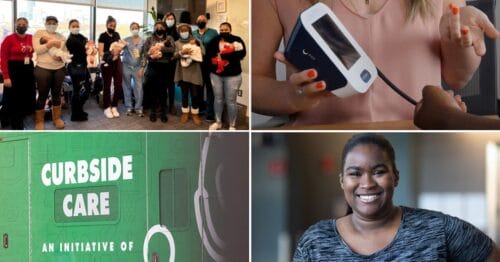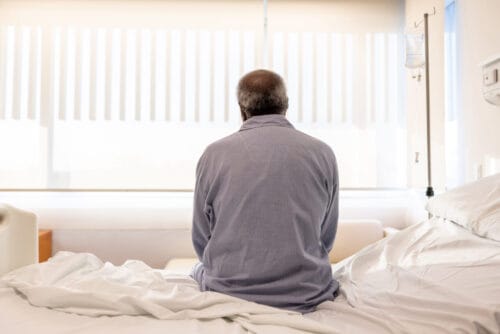How A Bereavement Program for Children and Teens Helps Close the Racial Grief Gap
June 14, 2022

SeventyFour, Getty Images
'Good Grief' Program provides therapeutic care to youth facing a significant loss and don't have access to this type of treatment anywhere else.
Even before the pandemic, children of color experienced more loss than white children, due to historical and persistent health inequities. The pandemic only widened this gap. As of October 2021, one of every 310 Black children and one of every 412 Latinx children experienced orphanhood or the death of a caregiver, compared to one of every 753 white children.
After a loss, children need the support of caring adults to make sense of their grief and to strengthen their strategies to cope. Established in 1996, the Good Grief Program at Boston Medical Center (BMC) provides therapeutic support to the hospital’s pediatric patients who have experienced a significant loss. “A large percentage of our families come to us after a death loss,” says program manager Maureen Patterson-Fede, MSW, LICSW. “But we also support families through abrupt moves, terminal diagnoses, and separation due to divorce, incarceration or immigration.” Patterson-Fede splits her time between the Good Grief Program and the Child Witness to Violence Project, which both provide outpatient subspecialty care within BMC’s Developmental and Behavioral Pediatrics department.
To learn more about how the Good Grief Program is supporting kids through loss and closing the racial grief gap, HealthCity spoke with Patterson-Fede, mental health and intake clinician Minelia Rodriguez, M.S., LMHC, and clinical intern Rachel Walsh, M.A.
HealthCity: How are grief and grief counseling issues of racial equity?
Maureen Patterson-Fede: There is consistent research that Black and brown kids have experienced more deaths and at younger ages compared to same-age white peers. We also know that there is a ripple effect of secondary losses after a death, impacting a range of things like access and wealth generation. Childhood bereavement is intricately weaved into the systemic forces that we know affect health equity.
Minelia Rodriguez: There’s also the issue of access to information and access to therapy. I’m bilingual, so I’m able to provide grief counseling in Spanish, which is great. But for some of our families who are new to the country, they may have a different understanding of what therapy is, so there can be a learning curve for them. And they also may be hesitant to engage with a formal helping system, particularly if they’re undocumented or if there is an ongoing custody issue.
Rachel Walsh: I’ve learned a lot about how to provide grief counseling and resources to families that otherwise wouldn’t really have access to them. It’s been really great to see the impact that we’re making on underserved families. Even if I don’t focus on grief counseling for my doctorate, grief will continue to come up in every field that I will work in.
HC: Why is it important that a childhood bereavement program like Good Grief be embedded in a hospital setting?
MPF: Most of our families come in with a primary loss, but sometimes it’s the secondary and tertiary losses that are actually what are most present for them. Being at BMC, where all of our providers understand that, gives us a lot of space to be able to holistically hold our families’ grief.
MR: Sometimes a family will come in with an identified loss, but we know that they could benefit from a higher level of care. We use the THRIVE screener to find out about social determinants of health like housing insecurity, food insecurity, issues with unemployment and caregiving. That initial needs assessment helps us be able to say, “Is your plate full? You seem more concerned about your housing situation than your grief right now, so let me help you with housing first.” We’re grief providers but we can also connect patients to community resources, a social worker, a navigator, or another person in the hospital who can help patients fulfill those other needs.
HC: How does the Good Grief Program work to address different cultural responses to grief?
MPF: We try to normalize grief as natural and not something to stigmatize or pathologize. Our families may not have had many conversations about their loss and how hurt they are. We offer them grace and space, and reassure them that what they’re going through is very, very hard and exactly what we would expect.
Central to our approach is an acknowledgement that we are often serving families who have experienced loss due to violence, incarceration, and immigration. I think the most important piece of our work is to make sure we are creating a space where those families can feel comfortable and start to share their story.
MR: Part of our assessment of families is around understanding their cultural and religious beliefs related to death and loss, as well as understanding what they know to be true about mental health and mental health services. Once we have that understanding, we then partner with the family to provide psychoeducation around childhood bereavement, childhood development, supportive parenting, and mental health, within the context of their cultural beliefs. Most of the time I see it as building a bridge between the clinical pieces and the cultural pieces, since we never want to position ourselves as the experts or invalidate a family’s cultural framework.
HC: What is the process for evaluating and treating a child?
MPF: For some period of time after a loss, we expect a child to struggle socially or with schoolwork. As they process the loss, they’re often able to move back to where things were about before the loss. Sometimes, something gets in the way of them being where they want to be. We look for the signs of a child being “stuck” and those are the patients we work with longer term.
MR: In terms of treatment, it just depends on what the family brings to the table and where they’re at currently. Some families are looking for grief counseling on an ongoing basis, while others are just looking for one or two consultations to learn how to move through the grief process at home. With younger children, the work is about giving the caregiver the tools to support the grieving child. For older kids, we do individual therapeutic work with them, and consult with the parent separately. There’s just so much need right now.
HC: Given the increased need, does the ‘Good Grief’ Program have any plans to expand?
MPF: We are in the fortunate position of being able to expand, having recently received one of the first grants from the new Moderna Charitable Foundation. They were looking for programs that were supporting families that had experienced a loss due to COVID, and more holistically, were addressing health inequities. They approached us because our program does both of those things, and we support families who don’t have access to this type of care anywhere else. The silver lining of the pandemic is that it made these conversations so much more salient.


